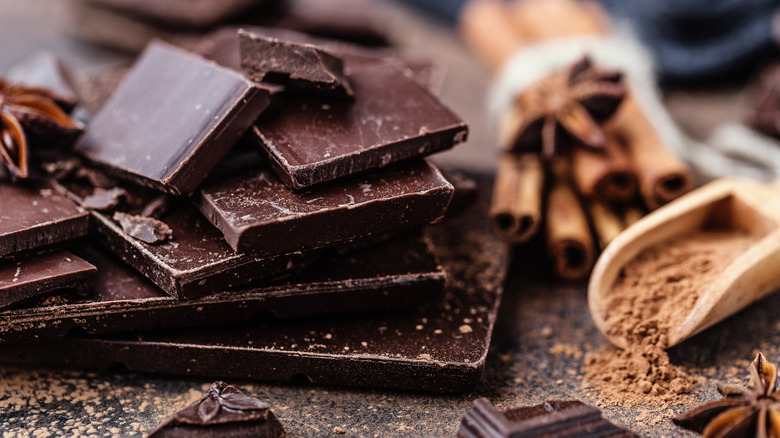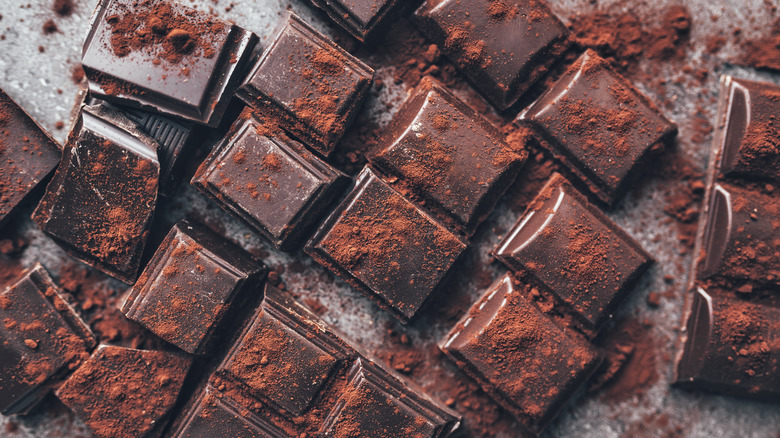What A Chocolate Bar's 'Snap' Will Tell You About Its Quality
Most people like chocolate in one way or another. While some people bill themselves "chocoholics," for most people, a love of chocolate just means enjoying a Hershey bar as a quick snack or a piece of chocolate cake for dessert. But outside of the realm of your average chocolate enjoyer or the self-proclaimed "chocoholic," there's a group of people who take chocolate very seriously, much like how there are people who treat alcoholic drinks like wine or whiskey with a professional, discerning air.
Known as "chocolatiers," these individuals are committed to the craft of chocolate. Far from the colorful Willy Wonka-esque confectionaries who live in delightfully absurd candy factories, becoming a chocolatier involves incredibly in-depth study and work. A student may travel to Canada's Ecole Chocolat Professional School of Chocolate Arts, for example, to not just study the history of chocolate but to also understand the chemical processes behind it — such as its texture, flavor, and shape — and how best to market and sell chocolate. These chocolatiers must treat chocolate not as a fun candy treat but as a serious culinary matter. This is how confectioners like Amaury Guichon can create fantastical (and wildly popular) sculptures using chocolate, thanks to a mastery of how chocolate "functions."
One key piece of knowledge all chocolatiers, novice or veteran, must know is how to identify high-quality chocolate. A simple trick to tell if chocolate is of high quality is to listen to the "snap" of a chocolate bar when it's broken.
Chocolate should snap rather than bend
If you've ever broken a piece of Kit Kat off to share with someone, you may have heard a little snapping sound when you did it. It was probably so faint that you didn't even think twice about it. But this is actually a good way to see if your chocolate is high quality.
When you have a piece of chocolate in your hands, break it in half and listen to the sound it makes. If it makes a snapping sound and breaks easily in your hand, that's the sign you have a quality chocolate bar. If the chocolate seems to bend or flex rather than make a clean break, then it may be a sign you have low-quality chocolate.
The reason good chocolate makes a clean break is that the chocolate is tempered — or heated and cooled to help control crystallized fat molecules inside the cocoa butter. If the chocolate has been tempered correctly, the end result means that the chocolate will be glossy and firm and can give you a clean, audible snap since the crystallized fat molecules have been stabilized. Low-quality chocolate may not be tempered correctly, or at all, or it may contain elements other than cocoa butter. This means that the unstable fat molecules, and possibly other elements within the chocolate, make it hard to break or snap easily.
It's best to do this with cooled or firm chocolate, as chocolate that's been exposed to heat won't snap easily no matter if it's high quality or not.
Dark chocolate has the best snap
You may decide that, with this new information, you're going to test out which chocolate bars are of the highest quality. You buy some cheap candy bars and you discover that most of the milk chocolate bars bend slightly before they snap. In comparison, dark chocolate bars have a clean snap. Does this mean that all milk chocolate bars are somehow low quality?
Not quite! The answer lies within the fact that, unlike milk or white chocolate (which usually include cream or milk in their recipes), dark chocolate has more cocoa butter in comparison, leading to dark chocolate having a very clean break. Milk and white chocolates can be of high quality, but dark chocolate will always have a better snap to it thanks to the lack of milk and other ingredients. If dark chocolate doesn't snap or has a crumbly, dry texture, that is a sign that the dark chocolate is also low quality.
If you're still unsure if your milk, white, or dark chocolate is high quality, it's best to give it a taste test. If it's smooth, creamy, and has a very noticeable chocolate flavor, it's obviously high quality or at least good to use. If the chocolate has a bitter, gritty, or chalky taste to it, then it's low quality.
If your chocolate manages to hold up in both taste and texture, then the good news is that you can rest easy knowing you're enjoying some darn fine chocolate.


